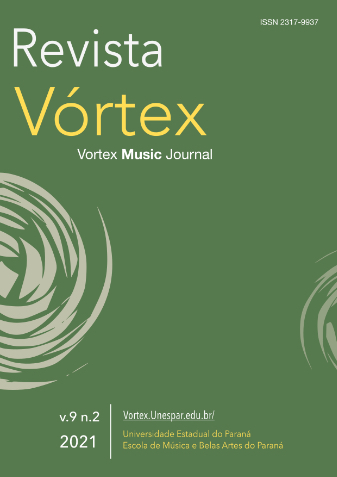Teledescante nº1: polyphony in time of plague
DOI:
https://doi.org/10.33871/23179937.2021.9.2.5Keywords:
Musical Composition, Referentiality, Metalanguage, Counterpoint, PolyphonyAbstract
This report contemplates an instrumental composition as a project for audiovisual production in social isolation, during the Covid-19 pandemic. Based on the problematization of the impact of the pandemic in music making, solutions were sought that were not only viable as an artistic result but that could also be projected in a purposeful and prospective way in times of humanitarian crisis, of dismal symmetry between capitalist neoliberalism and programmed neglect in public health policies. After a description of the research on the use of art in past pandemics as a guiding principle in the choice of materials, the audiovisual production is detailed. The piece was written in April 2020 as a result of the analysis of a Renaissance motet, which, in turn, was conceived as a tribute to a composer who had perished from the plague and as a palliative against the disease.Downloads
References
DE BONIS, Maurício Funcia. Tabulae scriptae: a metalinguagem e as trajetórias de Henri Pousseur e Willy Corrêa de Oliveira. São Paulo: Editora UNESP Digital, 2014. Available at https://doi.org/10.7476/9788568334379. Access on September 11th, 2021.
______. Teledescante nº1 (cesset jam manus tua). Paris: Babelscores, 2020. Available at https://www.babelscores.com/catalogs/instrumental/6716-teledescante-n-1. Access on September 11th, 2021.
BOWEN, William. The Contribution of French Musicians to the Genesis of the Italian Madrigal. Renaissance and Reformation, Toronto, v.27, n.2, p.101-114, 2003. Available at https://doi.org/10.33137/rr.v39i2.8872. Access on May 26th, 2021.
GRADUALE Sacrosanctae Romanae Ecclesiae: de tempore et de sanctis. Tournai: Desclée & Socii, 1961.
HANSKA, Jussi. Strategies of sanity and survival: religious responses to natural disasters in the Middle Ages. Helsinki: Finnish Literature Society, 2002.
LOCKWOOD, Lewis. Music in Renaissance Ferrara, 1400-1505: the creation of a musical center in the fifteenth century. New York: Oxford University Press, 2009.
MACKLIN, Christopher Brian. Musica sanat corpus per animam: towards an understanding of the use of music in response to Plague, 1350-1600. 2018. Thesis (Doctoral, Music). University of York. Available at https://etheses.whiterose.ac.uk/14146/. Access on May 26th, 2021.
______. Stability and Change in the Composition of a "˜Plague Mass"™ in the Wake of the Black Death. Plainsong and Medieval Music, Cambridge, v.25, n.2, p.167–89, 2016. Available at https://doi.org/10.1017/S0961137116000024. Access on May 26th, 2021.
OBRECHT, Jacob. Parce Domine. For three voices. Copenhagen: Peter Woetmann Christoffersen, 2014. Available at http://amiens.pwch.dk/Contents/Am162f018.html. Access on May 26th, 2021.
PADEN, William D. An Occitan Prayer against the Plague and Its Tradition in Italy, France, and Catalonia. Speculum, Chicago, v.89, n.3, p.670-692, 2014. Available at https://doi.org/10.1017/S003871341400075X. Access on May 26th, 2021.
SCHWARCZ, Lilia Moritz; STARLING, Heloisa Murgel. A bailarina da morte: a gripe espanhola no Brasil. São Paulo: Companhia das Letras, 2020.
SLIM, H. Colin. A gift of madrigals and motets, volume I: description and analysis. Chicago: University of Chicago Press, 1972.
SMITH, Anne. The Performance Of 16th-Century Music: learning from the theorists. New York: Oxford University Press, 2011.
VERDELOT, Philippe. Recordare domine / Adjuva nos. In: ATTAIGNANT, Pierre (ed.). Liber quartus, XXIX: musicales quatuor vel quinque parium vocum modulos habet. Paris: Pierre Attaignant, 1534. Available at https://imslp.org/wiki/Motettorum%2C_Book_4_(Attaingnant%2C_Pierre). Access on May 26th, 2021.
______. Recordare domine / Adjuva nos. In: MODERNE, Jacques (ed.). Secundus liber cum quinque vocibus. Lugduni: Iacobum Modernum de Pinguento, 1532. Available at https://www.digitale-sammlungen.de/de/view/bsb00075662. Access on May 26th, 2021.
Downloads
Published
How to Cite
Issue
Section
License
Copyright (c) 2021 Maurício Funcia De Bonis, Fábio Scucuglia

This work is licensed under a Creative Commons Attribution 4.0 International License.
Autores mantêm os direitos autorais e concedem à revista o direito de primeira publicação, com o trabalho simultaneamente licenciado sob a Licença Creative Commons Attribution que permite o compartilhamento do trabalho com reconhecimento da autoria e publicação inicial nesta revista.






